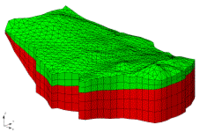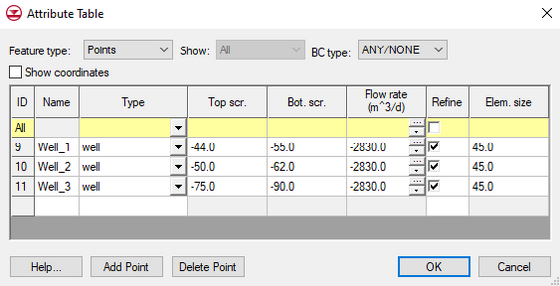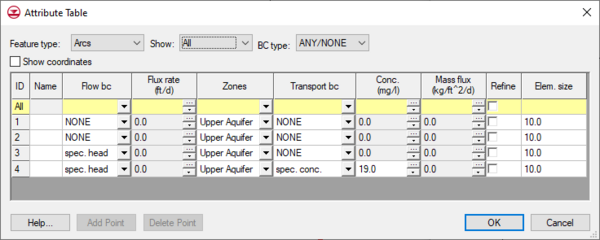GMS:FEMWATER Point / Arc Properties: Difference between revisions
From XMS Wiki
Jump to navigationJump to search
| (4 intermediate revisions by the same user not shown) | |||
| Line 14: | Line 14: | ||
{| | {| | ||
|- | |- | ||
|[[Image:screenlogic.png|thumb|none|380 px|''The distribution of flux rate to nodes overlapped by well screen.'']] | |valign="top"|[[Image:screenlogic.png|thumb|none|380 px|''The distribution of flux rate to nodes overlapped by well screen.'']] | ||
|[[File:FEMWATER PointProp.png|thumb|none|560 px|Example of the FEMWATER point ''Attribute Table'' dialog]] | |[[File:FEMWATER PointProp.png|thumb|none|560 px|Example of the FEMWATER point ''Attribute Table'' dialog]] | ||
|} | |} | ||
| Line 24: | Line 24: | ||
*''Flow bc'' – The ''Flow bc'' option is used to define a specified head or specified flux boundary. If this option is selected in the drop-down list. The available options are: | *''Flow bc'' – The ''Flow bc'' option is used to define a specified head or specified flux boundary. If this option is selected in the drop-down list. The available options are: | ||
**''Specified head'' – If this option is selected, a head value is assigned to each of the two nodes at the endpoints of the arc. If the two values at the endpoints are different, the head is assumed to vary linearly along the arc length. When the [[GMS:Map to Models#Map to FEMWATER|'''Map → FEMWATER''']] command is selected, all nodes on the boundary of the mesh beneath the arc are found and the nodes are marked as specified head nodes. A linearly interpolated head value is assigned to each node. | |||
*''Specified head'' – If this option is selected, a head value is assigned to each of the two nodes at the endpoints of the arc. If the two values at the endpoints are different, the head is assumed to vary linearly along the arc length. When the [[GMS:Map to Models#Map to FEMWATER|'''Map → FEMWATER''']] command is selected, all nodes on the boundary of the mesh beneath the arc are found and the nodes are marked as specified head nodes. A linearly interpolated head value is assigned to each node. | **''Specified flux'' – If this option is selected, a flux value is assigned to the arc in the Flux rate column of the spreadsheet. When the [[GMS:Map to Models#Map to FEMWATER|'''Map → FEMWATER''']] command is selected, all vertical element faces on the boundary of the mesh beneath the arc are found and the specified flux rate is assigned to the faces. | ||
**''Variable flux'' – If this option is selected, a flux value is assigned to the arc. When the [[GMS:Map to Models#Map to FEMWATER|'''Map → FEMWATER''']] command is selected, all vertical element faces on the boundary of the mesh beneath the arc are marked as variable boundary faces. If a flux value of zero (the default value) is assigned, the element faces represent a seepage face boundary where below the water table, the head is set equal to the elevation. | |||
*''Specified flux'' – If this option is selected, a flux value is assigned to the arc in the Flux rate column of the spreadsheet. When the [[GMS:Map to Models#Map to FEMWATER|'''Map → FEMWATER''']] command is selected, all vertical element faces on the boundary of the mesh beneath the arc are found and the specified flux rate is assigned to the faces. | |||
*''Variable flux'' – If this option is selected, a flux value is assigned to the arc. When the [[GMS:Map to Models#Map to FEMWATER|'''Map → FEMWATER''']] command is selected, all vertical element faces on the boundary of the mesh beneath the arc are marked as variable boundary faces. If a flux value of zero (the default value) is assigned, the element faces represent a seepage face boundary where below the water table, the head is set equal to the elevation. | |||
*''Contaminant'' – The ''Contaminant'' option is used to model concentration or mass flux boundary conditions. This option is selected in the ''Transport bc'' column in the spreadsheet. The available options are: | *''Contaminant'' – The ''Contaminant'' option is used to model concentration or mass flux boundary conditions. This option is selected in the ''Transport bc'' column in the spreadsheet. The available options are: | ||
| Line 37: | Line 33: | ||
*''Specified mass flux'' – If this option is selected, a mass flux value is assigned to the arc using the Mass flux column. When the [[GMS:Map to Models#Map to FEMWATER|'''''Map → FEMWATER''''']] command is selected, all vertical element faces on boundary of the mesh beneath the arc are found and the specified mass flux rate is assigned to the faces. | *''Specified mass flux'' – If this option is selected, a mass flux value is assigned to the arc using the Mass flux column. When the [[GMS:Map to Models#Map to FEMWATER|'''''Map → FEMWATER''''']] command is selected, all vertical element faces on boundary of the mesh beneath the arc are found and the specified mass flux rate is assigned to the faces. | ||
*''Variable (concentration)' – If this option is selected, a concentration value is assigned to the arc using the ''Concentration'' column. When the [[GMS:Map to Models#Map to FEMWATER|'''Map → FEMWATER''']] command is selected, all element faces on the boundary of the mesh beneath the arc are found and the specified concentration is assigned to the faces as a variable type boundary condition. Note that this boundary condition can be used in conjunction with any of the three options for specified head/fluid flux. The proper use of this type of boundary condition is explained in the [http://gmsdocs.aquaveo.com/Femwater.pdf FEMWATER Reference Manual]. | *''Variable (concentration)'' – If this option is selected, a concentration value is assigned to the arc using the ''Concentration'' column. When the [[GMS:Map to Models#Map to FEMWATER|'''Map → FEMWATER''']] command is selected, all element faces on the boundary of the mesh beneath the arc are found and the specified concentration is assigned to the faces as a variable type boundary condition. Note that this boundary condition can be used in conjunction with any of the three options for specified head/fluid flux. The proper use of this type of boundary condition is explained in the [http://gmsdocs.aquaveo.com/Femwater.pdf FEMWATER Reference Manual]. | ||
*''Assigning to Zones'' – The ''Zone'' column is used to determine how the boundary conditions are applied to the nodes and element faces when the [[GMS:Map to Models#Map to FEMWATER|'''Map → FEMWATER''']] command is selected. By default, the boundary conditions are assigned to all nodes and element faces beneath the arc. However, in some cases it is useful to restrict the boundary condition to only a portion of the vertical boundary beneath the arc. This can be accomplished by selecting the Selected zones only option and marking the material zones where the boundary condition is to be applied. | *''Assigning to Zones'' – The ''Zone'' column is used to determine how the boundary conditions are applied to the nodes and element faces when the [[GMS:Map to Models#Map to FEMWATER|'''Map → FEMWATER''']] command is selected. By default, the boundary conditions are assigned to all nodes and element faces beneath the arc. However, in some cases it is useful to restrict the boundary condition to only a portion of the vertical boundary beneath the arc. This can be accomplished by selecting the Selected zones only option and marking the material zones where the boundary condition is to be applied. | ||
| Line 53: | Line 49: | ||
*''Material'' – The ''Material'' pull-down list can be used to associate a material with a polygon. When the [[GMS:Map to Modules#Map to 2D Mesh|'''Map → 2D Mesh''']] command is selected, all 2D elements within the polygon are assigned the specified material. This material can be used to define the material type for the 3D elements when the 2D elements are extruded using the '''Fill Between TINs → 3D Mesh''' command. | *''Material'' – The ''Material'' pull-down list can be used to associate a material with a polygon. When the [[GMS:Map to Modules#Map to 2D Mesh|'''Map → 2D Mesh''']] command is selected, all 2D elements within the polygon are assigned the specified material. This material can be used to define the material type for the 3D elements when the 2D elements are extruded using the '''Fill Between TINs → 3D Mesh''' command. | ||
*''Fluid Flux'' – The ''Fluid flux'' option is used to assign a specified flux to the polygon. The flux can be assigned using either the Specified flux or Variable flux options. These options are set in the ''Flow bc'' drop-down list. When the '''Map → FEMWATER''' command is selected, all element faces on the top of the 3D mesh inside the polygon are found and the specified flux is assigned to the element faces. | *''Fluid Flux'' – The ''Fluid flux'' option is used to assign a specified flux to the polygon. The flux can be assigned using either the ''Specified flux'' or ''Variable flux'' options. These options are set in the ''Flow bc'' drop-down list. When the '''Map → FEMWATER''' command is selected, all element faces on the top of the 3D mesh inside the polygon are found and the specified flux is assigned to the element faces. | ||
*''Contaminant'' – The Contaminant option is used to assign a mass flux or a concentration. If the Specified mass flux option is selected, the specified mass flux rate is assigned to all element faces on the top of the mesh when the '''''Map → FEMWATER''''' command is selected. If the Variable (concentration) option is selected, the specified concentration is assigned to all element faces inside the polygon. | *''Contaminant'' – The Contaminant option is used to assign a mass flux or a concentration. If the ''Specified mass flux'' option is selected, the specified mass flux rate is assigned to all element faces on the top of the mesh when the '''''Map → FEMWATER''''' command is selected. If the ''Variable (concentration)'' option is selected, the specified concentration is assigned to all element faces inside the polygon. | ||



